VW Part Numbers Explained
This blog attempts to explain the VW Group part number system. The system used dates back to the 1930s and the original designs created by Ferdinand Porsche. It may look scary, but once you learn the basics, you’ll find that the system is quite consistent and makes things easier to understand.
In addition to VW, this part numbering system is applicable to the entire
Volkswagen Group, which includes SEAT, Skoda and Audi, as well as other brands such as Bentley, Bugatti, Lamborghini and Porsche.
Below aims to address the common conventions. There are some (probably quite a lot) of exceptions to these rules, but generally the information is correct.
Something to be mindful of. The letter O is not normally used in the part numbers. So 1J0 is correct, not 1JO.
Looking up part numbers
Part numbers and fitment information can be found through ETKA, the electronic parts number catalogue for VAG. Official legal copies of ETKA are expensive, and normally reserved for dealerships and high level parts suppliers. However, for about £30/month, independent users and businesses can purchase access to an online version, called partslink24, and search part numbers and place orders online. The subscription will also gives you the ability to identify the exact parts that are fitted to a specific vehicle by entering the Vehicle Identification Number (VIN).
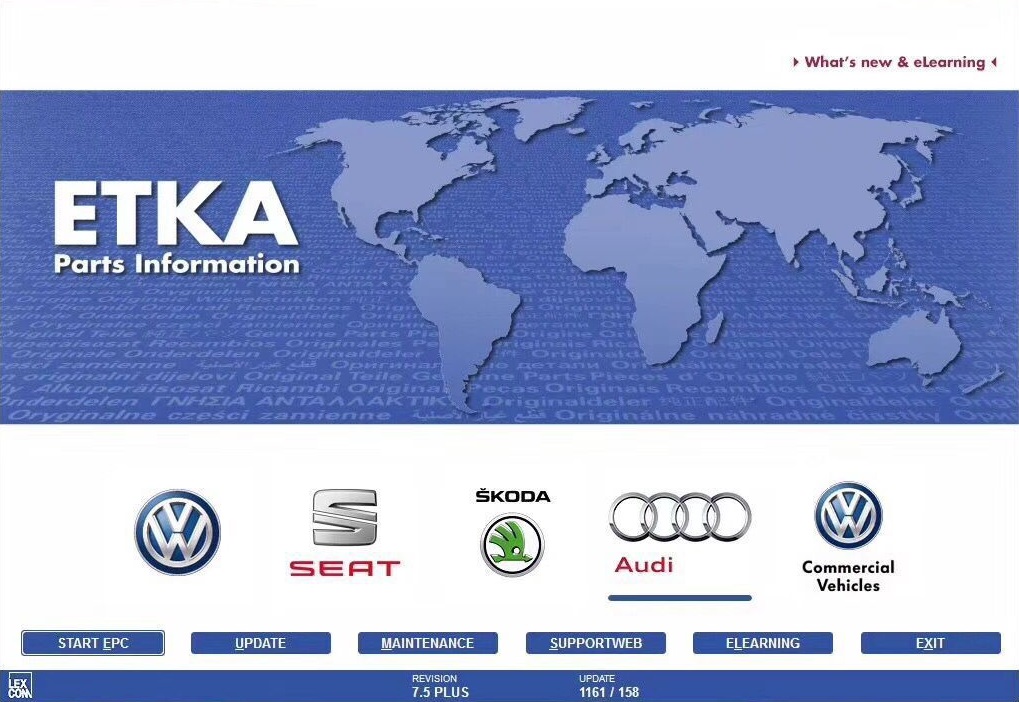
Audi & VW Part Number Structure
The basic part number structure normally has nine characters. In many cases, additional suffix characters are added to indicate special part characteristics such as colour, design variations, etc. Even though sometimes part numbers are written without spaces, for example, 1K0805903JGRU - a Mk5 Golf Front Splitter / Spoiler. It helps to think of it as several groups of characters: 1K0 805 903 J GRU. The graphic below shows how the number is built and how to interpret the groups of numbers/letters.
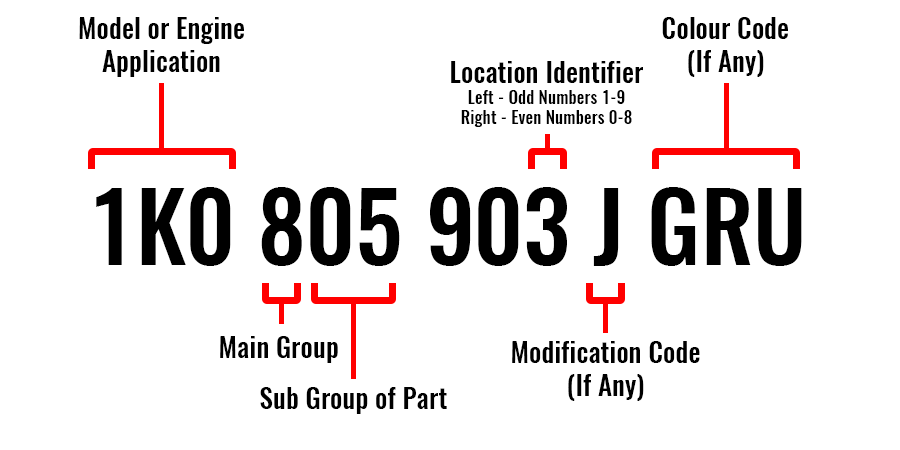
Set 1: Model / Engine / Transmission Code
The first three characters normally indicate the vehicle type, engine, or transmission that the part was designed for. It can consist of letters and/or numbers. In this case, 1K0 indicates a Golf from ~2004 - 2008 (Mk5 chassis). All parts made for a specific model, body style variation, engine or transmission have the same first three-character part number code. Since many parts can be used on more than one model, the first three digits do not restrict the part to that model alone, normally just what is was initially fitted to.
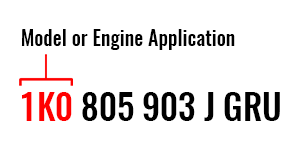
As another example, part number 074 115 562 is an oil filter. An oil filter like this might fit some other models. So in this case the first three digits, 074, do not designate a particular model, but which engine the oil filter was first developed for.
Every individual model, body style variation, engine and transmission has its own three-character code. The list is extensive, but here are several examples:
- 038 = 4 Cylinder Diesel PD engines
- 1J0 = VW Golf 1999 - 2004 (Mk4 chassis)
- 0A5 = 6-Speed Manual Transmission mainly found in the T5 2.5 TDIs
- 0BY = Haldex rear differential found on the MQB Platform vehicles
Set 2: Main Group and Subgroup
Main Group
The first digit of the second group of three characters identifies the part as belonging to one of ten Main Groups. Once you know these, you’ll see at a glance the type of component or system the part belongs to.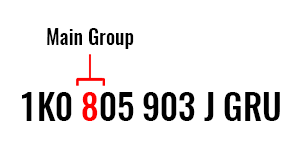
Here are the identifying numbers for the ten Main Groups.
- Engine
- Fuel, Exhaust, Cooling
- Gearbox / Transmission
- Front Axle, Differential, Steering
- Rear Axle
- Wheels and Brakes
- Hand and Foot Levers, Pedals
- Body Parts and Interior Trim
- Electrical and Electrical Systems
- Accessories - Jacks, Tools, Stickers, and Radio Equipment etc
Using this system, the part we have is falls into the 'Body Parts and Interior Trim' category.
Subgroup
The next two characters identify Subgroups of parts within a Main Group. For example, in Main Group 8 for Body parts, there are Subgroups for subsystems such as front and rear bumpers (807), wings (821), doors (831 for front and 833 for rear), rear seats (885), and so on.
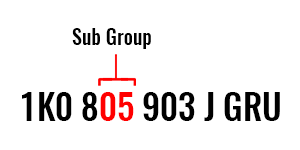
In our example the subgroup means that this part can be found in section 05 of main group 8, which is 'Bodywork Front Part' (805).
Repair Kits
A repair kit contains the parts needed for a specific repair (a brake pad set, cambelt / timing belt kit, or a hose repair set). Brake pads, for example, always come in axle sets, as they should always replaced this way. The middle three digits of a repair kit part number can help identify it, as shown in the following example: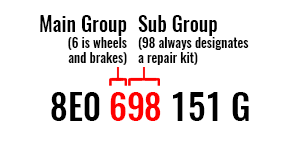
This example is a brake pad set for an Amarok 2010 - 2018 (2H chassis). Whenever the Subgroup – the fifth and sixth digits of the part number sequence is 98, it means the part is a repair kit or set. The Subgroup 98 applies to all Main Groups 1–10. Bare in mind not all Kits / Sets have 98 in the part number. Another example: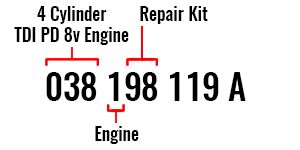
This is a Cambelt / Timing Belt Repair Kit for the 1.9 and 2.0 8v PD Engines. This means the customer does not need to purchase each individual bolt, pulley and belt required to do the job in question.

Set 3: The Part Number
The actual part within a Subgroup is identified in the last three digits of the part number. This set is almost always numbers, no letters.
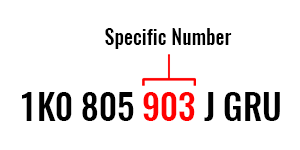
However, the numbers aren’t just sequential. Here are a few rules for the third set:
Major Assemblies begin with a Zero
- 038100036H - AWX 1.9 TDI Engine
- 0A8300043KX - GUC 6 Speed Gearbox as fitted to our Ibiza Race Car
If the part is available in a left or a right side version, the last number in the actual part number sequence is either an even or an odd digit. An even digit usually indicates a right-side part, and an odd digit usually indicates a left-side part. Parts that could be used on either side generally have an odd digit:
- 1K8 945 095 R - Left Side Rear Tail Light from a Scirocco R Line
- 1K8 945 096 R - Right Side Rear Tail Light from a Scirocco R Line
In part locations on a vehicle, left, right, front, or rear is always determined from the driver’s seat facing forward.
Set 4: Modification Codes
Parts are sometimes modified or changed (different design, different supplier, and different materials). If a part is modified, a modification letter is added to the nine-digit base part number.
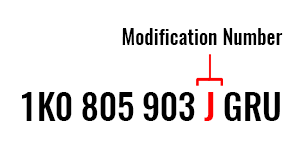
In our example, the item is a 30th Edition GTI Front Splitter / Spoiler, and is designated by a modified part number shown with the letter 'J'. Part numbers with modification letters may or may not interchange with previous parts because of the modification, even though they share the same base part number, except for the letter modification. The modification letter or letters, which can be either in the 10th or in the 10th and 11th position of the part number, can also indicate a different version of the part. In this case, the part number ending 'H' is an ordinary GTI Splitter and 'A' is the base model Splitter.
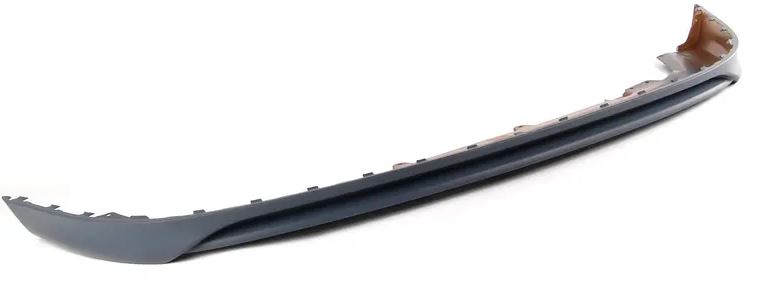
Normally there is only one modification letter or designation, but a frequently modified part may have two letters. And the alphabetical sequence of the modification letter normally indicates how many modifications or versions have been made. A part may also be modified before manufacturing at the factory, after it has been assigned a part number. It then has a modification code from the start.
PLEASE be careful when checking compatibility of parts. Simply matching the first x number of digits is not sufficient to guarantee that a part will fit.
Re-manufactured or Exchange Parts
The part numbers of re-manufactured parts are similar to those for most other parts. They generally have the same part number as the brand new item, however, the letter X always occurs as the last digit in the part number. Here is an example:
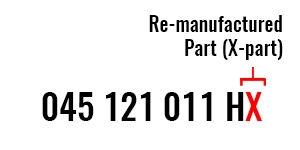
Some parts are exceptions to the above rule. For example, PD Injectors. The ARL PD150 Injector part number is 038 130 073 AL
, however the exchange part number is 038 130 079 BX, which can be quite confusing when trying to cross reference! Another example are Fuel Pumps:
059 130 755 N - New Unit
059 130 851 AX - Exchange Part
Exchange parts carry a Surcharge that is refunded when the old unit is returned to the dealer for credit. In most cases, the exchange part is less expensive than a new one once credited, but can be the same price or even more expensive if the core part is not returned. This is something to keep in mind when buying exchange parts, especially when overseas, as shipping costs and import duties also add up. Most dealers also impose a 30 day limit on credits for surcharges.
Set 5: Colour Code
Some part numbers have a colour code. which generally at the end of the part number. In our example, the splitter is 'GRU' or 'Primed'.
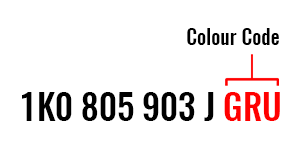
If it’s included it can be a mix of letters or numbers. This is often found on interior trim and seats since there are so many colour combinations. 'GRU' always means means primed or ready to paint. A few common examples of the colour codes are:
- 3FZ = Textured Satin Black Plastic
- Q70 = Light Beige
- U71 = Flannel Grey
- B41 = Black
- A9W = Carbon Steel Metallic
Some examples of these colours can be seen in the Armrest Clip Repair Kits in our shop. There are quite a few codes just for Black, some determining whether it is textured plastic, metallic, gloss, matte and other finishes.
Fluids and Hardware
Fluids and small hardware have numbers preceded by capital letters to help identify the type of material or application:
- G = Lubricants and coolant - For example G052171A2 is 02M / 02Q Gearbox Oil
- D, AKD, AMV = Sealing compounds and adhesives - AKD49701004 is a 10m long strip of sticky plastic strip for sealing bumper gaps
- B = Brake fluids and pastes - B000750M3 is 1L of Brake Fluid
- N = bolts, nuts, clamps, gaskets, etc. - N90200604 is an Inlet Manifold Bolt for the 1.9 and 2.0 8v PD Engines
Supersessions
Another concept to discuss are Supersessions. You may see it written as superseeded, superseded and other ways. Basically they are replacement parts. Generally a supersession will replace a part exactly. It may be an improved part (VW do not get it right first time either!) or just made by another manufacturer for some reason. In rare instances, a part is superseded by several other parts, so it is not a direct fit. This may be because a major issue is highlighted with the part, and simply replacing that item would not be sufficient to rectify the problem.

My favourite part for this is the Tandem Pump for the 8v PD Engines. It has a long list of supersessions:
038 145 209
038 145 209 A
038 145 209 C
038 145 209 E
038 145 209 H
038 145 209 K
038 145 209 N
038 145 209 M
038 145 209 Q
But when you look further into it, there is a tangled web, where some part numbers skip further down the list (depending what Engine Code or vehicle you are looking at), the Manufacturer changes from LuK, to Bosch, to Pierburg as well as the Rubber Seal changing to a Gasket. In this instance, the parts are completely interchangeable, but if you have a pump with a seal, you need a seal. If it has a gasket, you need a gasket.
Hopefully this information has helped you get your head around what looks like a complicated system, but is actually pretty well organised and methodical!
Recent Posts
-
Silverstone GP - ClubEnduro - 750MC - 29th October 2023
An unusual calendar for 2023 meant that round 7, the final round of the season for the 750MC Club En …23 11 2023 -
750MC Birkett Relay - Silverstone GP - 28th October 2023
With a hectic season of racing almost to a close, we were back at Silverstone for the 750 Motor Club …15 11 2023 -
Snetterton 300 - BRSCC TTCR - 13th-15th October 2023
For Round 6 of the BRSCC Audi TT Cup Racing, we were at Croft, which turned out to be VERY eventful …20 10 2023




